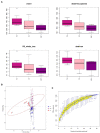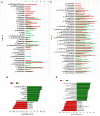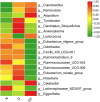Comparison of Intestinal Microbes in Noninfectious Anterior Scleritis Patients With and Without Rheumatoid Arthritis
- PMID: 35756002
- PMCID: PMC9218904
- DOI: 10.3389/fmicb.2022.925929
Comparison of Intestinal Microbes in Noninfectious Anterior Scleritis Patients With and Without Rheumatoid Arthritis
Abstract
We compared intestinal microbes in anterior noninfectious scleritis patients with and without rheumatoid arthritis. Active noninfectious anterior scleritis patients without other immune diseases (G group, 16 patients) or with active rheumatoid arthritis (GY group, seven patients) were included in this study. Eight age- and sex-matched healthy subjects served as controls (N group). DNA was extracted from fecal samples. The V3-V4 16S rDNA region was amplified and sequenced by high-throughput 16S rDNA analysis, and microbial contents were determined. A significant decrease in species richness in the GY group was revealed by α- and β-diversity analyses (p = 0.02 and p = 0.004, respectively). At the genus level, 14 enriched and 10 decreased microbes in the G group and 13 enriched and 18 decreased microbes in the GY group were identified. Among them, four microbes were enriched in both the G and GY groups, including Turicibacter, Romboutsia, Atopobium, and Coprobacillus. Although two microbes (Lachnospiraceae_ND3007_group and Eggerthella) exhibited similar tendencies in the G and GY groups, changes in these microbes were more significant in the GY group (p < 0.05). Interaction analysis showed that Intestinibacter, Romboutsia, and Turicibacter, which were enriched in both the G and GY groups, correlated positively with each other. In addition, nine microbes were decreased in the GY group, which demonstrates a potential protective role for these microbes in the pathogenesis of scleritis via interactions with each other.
Keywords: Atopobium; Coprobacillus; Romboutsia; Turicibacter; intestinal microbes; noninfectious anterior scleritis; rheumatoid arthritis; scleritis.
Copyright © 2022 Li, Yang, Zhao, Bai and Liu.
Conflict of interest statement
The authors declare that the research was conducted in the absence of any commercial or financial relationships that could be construed as a potential conflict of interest.
Figures





Similar articles
-
Enriched and Decreased Intestinal Microbes in Active VKH Patients.Invest Ophthalmol Vis Sci. 2022 Feb 1;63(2):21. doi: 10.1167/iovs.63.2.21. Invest Ophthalmol Vis Sci. 2022. PMID: 35142786 Free PMC article.
-
[Characteristics of intestinal flora in patients with primary Sjögren syndrome].Nan Fang Yi Ke Da Xue Xue Bao. 2020 Jul 30;40(7):949-957. doi: 10.12122/j.issn.1673-4254.2020.07.06. Nan Fang Yi Ke Da Xue Xue Bao. 2020. PMID: 32895147 Free PMC article. Chinese.
-
Scleritis associated with rheumatoid arthritis and with other systemic immune-mediated diseases.Ophthalmology. 1994 Jul;101(7):1281-6; discussion 1287-8. Ophthalmology. 1994. PMID: 8035992
-
Management of noninfectious scleritis.Ther Adv Ophthalmol. 2022 Jan 21;14:25158414211070879. doi: 10.1177/25158414211070879. eCollection 2022 Jan-Dec. Ther Adv Ophthalmol. 2022. PMID: 35083421 Free PMC article. Review.
-
Rheumatoid Arthritis Associated Episcleritis and Scleritis: An Update on Treatment Perspectives.J Clin Med. 2021 May 14;10(10):2118. doi: 10.3390/jcm10102118. J Clin Med. 2021. PMID: 34068884 Free PMC article. Review.
Cited by
-
Persea americana Peel: A Promising Source of Nutraceutical for the Mitigation of Cardiovascular Risk in Arthritic Rats Through the Gut-Joint Axis.Biomolecules. 2025 Apr 16;15(4):590. doi: 10.3390/biom15040590. Biomolecules. 2025. PMID: 40305360 Free PMC article.
-
Study of gut microbiome alterations in plaque psoriasis patients compared to healthy individuals.Postepy Dermatol Alergol. 2024 Aug;41(4):378-387. doi: 10.5114/ada.2024.142394. Epub 2024 Aug 21. Postepy Dermatol Alergol. 2024. PMID: 39290901 Free PMC article.
-
Identifying TNF and IL6 as potential hub genes and targeted drugs associated with scleritis: A bio-informative report.Front Immunol. 2023 Mar 31;14:1098140. doi: 10.3389/fimmu.2023.1098140. eCollection 2023. Front Immunol. 2023. PMID: 37063831 Free PMC article.
-
Exploring the Association between Gut Microbiota and Inflammatory Skin Diseases: A Two-Sample Mendelian Randomization Analysis.Microorganisms. 2023 Oct 19;11(10):2586. doi: 10.3390/microorganisms11102586. Microorganisms. 2023. PMID: 37894244 Free PMC article.
References
-
- Aletaha D., Neogi T., Silman A. J., Funovits J., Felson D. T., Bingham C. O., 3rd, et al. . (2010). 2010 rheumatoid arthritis classification criteria: an American College of Rheumatology/European League Against Rheumatism collaborative initiative. Ann. Rheum. Dis. 69, 1580–1588. doi: 10.1136/ard.2010.138461, PMID: - DOI - PubMed
LinkOut - more resources
Full Text Sources

